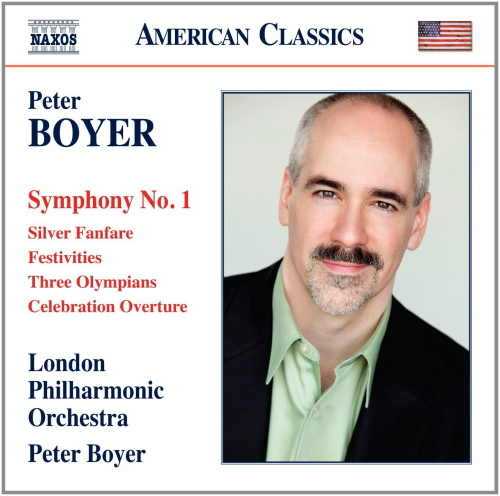
Composer: Peter Boyer
Orchestra: London Philharmonic Orchestra
Conductor: Peter Boyer
Audio CD
Number of Discs: 1
Format: FLAC (tracks)
Label: Naxos
Size: 1.03 GB
Recovery: +3%
Scan: yes
1. Silver Fanfare (2004) For Orchestra
2. Festivities (2011) For Orchestra
Three Olympians:
3. I. Apollo
4. II. Aphrodite
5. III. Ares
6. Celebration Overture (1997, Rev. 2001) For Orchestra
Symphony No.1:
7. I. Prelude
8. II. Scherzo/Dance
9. III. Adagio
SUPERB NEW RECORDING FROM PETER BOYER
I’m enjoying the disc now as I write this reply. First of all, before I proceed, I must say up front that the very first notes impressed me with both a clarity of timbre and detail in the orchestration and the naturalness of a rich and reverberant hall. The very sound itself that composer/conductor Peter Boyer, the London Philharmonic Orchestra, and the engineer achieved in the big room at Abbey Road is nothing less than thrilling at every moment. What is particularly evident is the sheen of the strings, and this really comes to the fore in the “Three Olympians,” which is scored for string orchestra alone. In fact, the quality of the string playing reminded me so strongly of the sound one heard from every recording of the Academy of St. Martin in the Fields under Neville Marriner. There is simply a tonal beauty, warmth, and vibrancy in the English string playing that is unmistakable, and it shines through on this disc. I always characterized English string playing as elegant, as though they were always playing with cufflinks on, and never in T-shirts. That kind of string playing stands apart from the rest of the world.
Of course, the mastery of Boyer’s writing, for the strings themselves, as well as the whole orchestral ensemble, obviously shows his awareness both of what these instruments are capable and how to achieve it. Not the least of the strengths of this recording is the composer’s conducting, as his work in this area is noted for its clarity, delineation of the music, precision, and the fluid nuances that add warmth and expression to the performance of excellent music.
Back to the music itself, and the big-ticket item is, of course, a brand new symphony. The very idea of tackling the concept of a “symphony” per se, as opposed to a programmatic “symphonic work,” must have been daunting indeed, but Boyer rose to the occasion with mastery of form and richness of musical imagination. The Copland and Bernstein influences in his music are graciously acknowledged by Mr. Boyer in his informative and succinct booklet notes, yet his music is neither derivative nor lacking in a personality that is distinctly his. This is music with a welcome foundation in tonality, though never lacking the “bite” contributed by a knowledge and skillful use of various “modernisms” that add interest and propulsion without bogging down as the sole raison d’être for the existence of the piece to begin with. The symphony progresses through a series of sound worlds that in turn caress, stimulate, excite and surprise the listener, always adding up to a satisfying musical journey that so many composers of late 20th century music fail to accomplish, or even try to achieve, I suppose deeming it unnecessary or undesirable to do so. Their loss, whereas Boyer’s music is our gain.
This new CD, in and of itself, is a model recording of clarity, richness, warmth, and excitement, one that belies its being recorded in a studio rather than a concert hall, and as an audio document is a magnificent achievement on that score alone. As music, it is rewarding and satisfying, all of it, and an excellent introduction to and sampling of this significant composer’s works, with the new symphony deserving a place in the concert going public’s attention. Congratulations to Peter Boyer for such an excellent work, and such an excellent disc with which to present it to the world.



